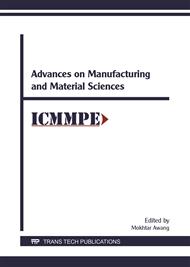[1]
Mustafa Ulutan, Osman N. Celik, Hakan Gasan, and Umit Er, Effect of Different Surface Treatment Methods on the Friction and Wear Behavior of AISI 4140 Steel, J. Mater. Sci (2010) 567.
DOI: 10.1016/s1005-0302(10)60042-4
Google Scholar
[2]
Fei Xie, Li Sun, Jianwei Pan, Characteristics and mechanisms of accelerating pack boriding by direct current field at low and moderate temperatures, Surface & Coatings Technology 206 (2012) 2839–2844. Technol., 2010, 26(3), 251-257.
DOI: 10.1016/j.surfcoat.2011.12.003
Google Scholar
[3]
Vipin Jain, G. Sundararajan . Influence of the pack thickness of the boronizing mixture on the boriding of steel. Surface and Coatings Technology 149 (2002) 21–26.
DOI: 10.1016/s0257-8972(01)01385-8
Google Scholar
[4]
Enver Atık, Umut Yunker, Cevdet Merıc The effects of conventional heat treatment and boronizing on abrasive wear and corrosion of SAE 1010, SAE 1040, D2 and 304 steels, Tribology International 36 (2003) 155–161.
DOI: 10.1016/s0301-679x(02)00069-5
Google Scholar
[5]
Iskender Akkurta, Adnan Calikb, Hakan Akyıldırıma, The boronizing effect on the radiation shielding and magnetization properties of AISI 316L austenitic stainless steel, Nuclear Engineering and Design 241 (2011) 55–58.
DOI: 10.1016/j.nucengdes.2010.10.009
Google Scholar
[6]
Kulka, M., Mikolajczak, D., Makuch, N., Dziarski, P., Miklaszewski, A., 2016. Wear resistance improvement of austenitic 316L steel by laser alloying with boron. Surface and Coatings Technology. 291 (2013) 292-313.
DOI: 10.1016/j.surfcoat.2016.02.058
Google Scholar
[7]
Kayali, Y. Investigation of diffusion kinetics of borided AISI P20 steel in micro-wave furnace. Vacuum (2015) 121, 129-134.
DOI: 10.1016/j.vacuum.2015.08.006
Google Scholar
[8]
Chunmin Li, Baoluo Shen , Guijiang Li, Chao Yang, Effect of boronizing temperature and time on microstructure and abrasion wear resistance of Cr12Mn2V2 high chromium cast iron. Surface & Coatings Technology 202 (2008) 5882–5886.
DOI: 10.1016/j.surfcoat.2008.06.170
Google Scholar
[9]
Dandan Mao , Xin Wang, Wurong Wang, Xicheng Wei, Effect of boronizing on the dry sliding wear behavior of DC53/0. 45 mass% C steel pairs, Surface & Coatings Technology 207 (2012) 190–19.
DOI: 10.1016/j.surfcoat.2012.06.061
Google Scholar
[10]
J.H. Yoon, Y.K. Jee and S.Y. Lee. Plasma paste boronizing treatment of the stainless steel AISI 304, Surface and Coatings Technology 112 (1999) 71–75.
DOI: 10.1016/s0257-8972(98)00743-9
Google Scholar
[11]
Gunes, S. Ulker, S. Taktak, Plasma paste boronizing of AISI 8620, 52100 and 440C steels, Materials and Design 32 (2011) 2380–2386.
DOI: 10.1016/j.matdes.2010.11.031
Google Scholar
[12]
S.O. Yılmaz, S. Karatas. Effect of mechanical activation on jell boronizing treatment of the AISI 4140 Applied Surface Science 275 (2013) 148– 155.
DOI: 10.1016/j.apsusc.2013.01.059
Google Scholar
[13]
Bartkowska, A., Swadźba, R., Popławski, M. and Bartkowski, D. Microstructure, microhardness, phase analysis and chemical composition of laser remelted FeB-Fe2B surface layers produced on Vanadis-6 steel. Optics & Laser Technology. 86 (2016).
DOI: 10.1016/j.optlastec.2016.07.010
Google Scholar
[14]
Kul, M., Oskay, K.O., Temizkan, A., Karaca, B., Kumruoğlu, L.C. and Topçu. B. Effect of boronizing composition on boride layer of boronized GGG-60 ductile cast iron. Vacuum. 126 (2016) 80–83.
DOI: 10.1016/j.vacuum.2016.01.021
Google Scholar
[15]
Tavakoli, H., Khoie, S.M., Rasooli, F., Marashi, S.P.H. and Momeni, F., 2015. Electrochemical and physical characteristics of the steel treated by plasma-electrolysis boronizing. Surface & Coatings Technology. 27 (2015) 529–533.
DOI: 10.1016/j.surfcoat.2015.06.020
Google Scholar


